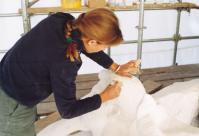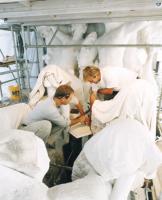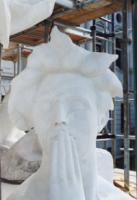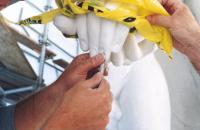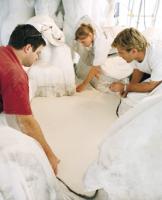Barnard Statuary Conservation MaintenanceIn 1902, artist George Grey Barnard was awarded the commission for the sculptural groups located at the main entrance of the Capitol. As soon as the general design for the sculpture was developed, Barnard left for France to begin the task of creating 27 marble figures. Barnard, plagued with personal and financial difficulties, was unable to complete the statues in time for the Capitol's dedication on October 4, 1906. It was not until 1910 that they were finished and exhibited at the Grande Palais in Paris. In May 1911, Barnard came to Harrisburg to supervise the installation and appeared before the General Assembly to explain his work. Speaking in the House Chamber, he noted that the south group begins with Adam and Eve and moves forward to the forms of Despair and Hope. This group as a whole is called "The Burden of Life" or "The Broken Law." The group to the north is named "Love and Labor" or "The Unbroken Law." This group begins with male and female figures reaping fruits of labor and advances to a youth and maiden, a new Adam and Eve, who gaze wonderingly toward the west as though into the future. The actual dedication of the sculpture was held on October 4, 1911, five years to the day after the Capitol was dedicated. In addition to their artistic beauty and intimate connection with the Capitol, the Barnard Statuary represents more than 75 years of stone conservation history. The years of exposure to Harrisburg's harsh weather conditions have taken their toll. As early as 1928, the sculptures showed signs of heavy soiling and deterioration. Barnard himself visited the Capitol that year to inspect the damage and to make recommendations for repairs. During his visit, he documented numerous cracks that had formed on the sculptures, some of them resulting in displacement of the figures. While Barnard was in Europe, the CoWaCo Company was contracted by the Commonwealth to clean and coat the sculptures with "a special transparent waterproofing compound" that would seal the surfaces and make the deteriorating stone more durable. Contrary to the artist's protests, the treatment was performed. In addition to performing these procedures, the restoration company repointed the monument and filled in areas where water was being trapped. By the end of the restoration project, more than 14 1/2 tons of concrete was used to stabilize the two groups. Years later, the statues were again in a state of disrepair. In 1947, calls from the governor and other politicians led to a second cleaning and waterproofing campaign involving the use of the "Caffal Process" by the Obelisk Waterproofing Company of New York. This process, at the time, reportedly strengthened the stone and was to provide a water-resistant surface using hot paraffin wax and petroleum solvents. The statues were periodically scrubbed and patched over the ensuing years. In 1962, the groups were cleaned and waterproofed by Vincent Maragliotti using a silicon compound. During the mid-1970s, the sculptures were sandblasted, resulting in the removal of pollution deposits, but also much of the fine detail and what was left of the original finish. In 1996, the statuary was disassembled and underwent a complete conservation treatment to help stabilize the cracked, fissured marble surfaces and the granite support bases. In an ongoing effort to help stabilize the deterioration processes and to prolong the life of these significant works of art, the Capitol Preservation Committee has undertaken a five-year conservation project. The project consists of two distinct phases: an intensive pre-cyclical maintenance program and a cyclical conservation maintenance program. The intensive pre-cyclical maintenance phase of the project, which began in July 2000, was completed in October 2001. The primary focus was to repair mortar joints, which includes the design and execution of a testing program to evaluate the effectiveness of various repair treatments and the implementation of a monitoring program to evaluate the treatment over a five-year period. The testing program consists of a series of tests to: 1) establish a conservation timeline in order to understand all previous treatments that were performed on the sculptural groups; 2) establish essential data on the nature and performance of the Carrara marble of the groups; 3) compare the effectiveness of various consolidation and water-repellent materials for Carrara marble; 4) evaluate any adverse interactions between the proposed conservation materials and those materials used in previous treatments; and 5) evaluate any possible interactions between the proposed conservation materials and the Carrara marble. The cyclical conservation maintenance phase is intended to prolong the effective lifespan of the conservation treatment that was performed during the intensive pre-cyclical maintenance program and to reduce the need for more costly, invasive conservation treatments in the future. By examining the successes and failures of previous treatments, we can learn valuable information for the future. The 1996 treatment was very successful because it corrected many of the structural problems associated with the groups and their bases. It also dealt with the cracks in the surfaces of the stone and was the first time that the marble and granite surfaces were cleaned using gentle chemicals and techniques. Results from the 1996 treatment also show that epoxy resin tends to darken when exposed to sunlight, and that another type of material should be used to fill cracks in the marble to help prevent the infiltration of moisture. We also learned that the mortar used to fill cracks and repoint the monument was not stable enough to withstand the repeated freeze-thaw climate cycles of Harrisburg. The current conservation program has addressed the epoxy and mortar issues in the following ways. All cracks and small fissures in the sculptures are being filled with dispersed hydrated lime injection putty (DHL). Although other forms of lime were available during the 1996 treatment, this specific product is relatively new to the conservation community. The material is completely compatible with the marble; it is stable in sunlight and is 100 percent reversible. In addition, since the material is so compatible with the marble and easy to color-match, the conservation team has been able to inject it into even the smallest cracks in the stone. To further help seal the surfaces of the marble and the joints between the various blocks of stone, we have chosen Jahn mortar—a proprietary mortar with a long and extensive history of success. It is designed specifically for marble and has been custom color matched for the Barnard sculptures. The product carries an extensive warranty against damage caused by salts and repeated freeze-thaw cycles. With these two products in place, the surfaces will be more watertight than ever before. It may appear that work on the Barnard Statuary is a never-ending process and that the figures are cloaked in scaffolding more often than not. In a certain sense this is true, because shortly after being installed in 1911, the sculptures began to rapidly deteriorate and as a result have required a great deal of maintenance over the years. Both the marble itself and the overall design of the groups contribute to the continual destruction of the monument. This poses a unique challenge for the Committee during its ongoing care of these priceless statues. The field of conservation is an ever-changing discipline where new ideas, materials, and techniques are continually introduced. The Committee strives to educate itself on the most current trends in the field of conservation. It also uses time-tested techniques and common sense in the design and treatment of the Capitol's Fine Art Collection. |
CONSERVATOR REMOVING FAILED GROUT JOINT
BARNARD STATUARY MAINTENANCE PROJECT IN PROGRESS
BARNARD STATUARY MAINTENANCE PROJECT AFTER TREATMENT
REATTACHMENT OF FINGERTIP
FIBERGLASS CAP IN PLACE READY FOR SEALANT |
